| Author |
Message |
|
Mikael Ranelius
|
 Posted: Thu 31 May, 2007 6:45 am Post subject: Bucklers used by men-at-arms? Posted: Thu 31 May, 2007 6:45 am Post subject: Bucklers used by men-at-arms? |
 |
|
|
Did Men-at-arms fought with sword and buckler, or was its use restricted to "lower" troops like archers and spearmen?
|
|
  |
 |
Craig Peters

|
|
  |
 |
Steven H

|
 Posted: Thu 31 May, 2007 1:44 pm Post subject: Posted: Thu 31 May, 2007 1:44 pm Post subject: |
 |
|
The short answer is clearly "yes".
That paper is quite thorough in providing the evidence to prove it.
Kunstbruder - Boston area Historical Combat Study
|
|
   |
 |
|
Hugh Knight
|
 Posted: Thu 31 May, 2007 2:13 pm Post subject: Posted: Thu 31 May, 2007 2:13 pm Post subject: |
 |
|
Actually, I think the answer is "mostly no" as long as we're talking about men at arms on the battlefield. Certainly every class used sword and buckler in civilian self defense, that's not open to debate. But after looking at literally thousands of iconographical references I have found that fully-armored men at arms (and that's the definition of a man at arms, really) are almost *never* shown with bucklers. There is one famous exception (and I'll post it so you can look at it), but that picture is almost unique. The simple fact is that medieval men, just like us, were individuals, and you can probably find an example of *any* weird deviation if you look hard enough, but that can't be used as "proof" of something being normal.
A regular shield is of a lot more use to a man at arms if he wants to use one; a buckler just isn't that protective by comparison. So the only real reason for using a buckler is when you want something less bulky, and, in fact, I can find *no* examples of armored buckler use prior to the late 13th/early 14th century--men at arms used heaters, kites, etc. After armor began to be mostly plate shields in general were mostly unnecessary, and while you occasionally see them, they are clearly falling out of fashion partly because the superior armor rendered them unnecessary and partly because the superior armor required two handed weapons. That means that the buckler was mostly used by lightly-armed support troops (e.g., bowmen and billmen) who wanted something for defense that wouldn't interfere with their normal gear. You will, at most, see billmen with a pretty comprehensive harness, but they're lacking gauntlets, etc.--and again, they're *billmen*, so they want a backup that won't interfere with their primary weapon. Men at arms usually seem to carry longswords and/or daggers and no buckler when they're armed with a two-handed weapon.
Another somewhat odd exception is military saints: St. Michael, for example, is often depicted in full harness but carrying a buckler; clearly there's some kind of Catholic significance to this, but I don't know what it is.
But go look at the iconography; you'll be hard pressed to find an example of a man at arms armed with a buckler except in the picture I attach below, and frankly, with only one (or even a handful) of examples, you have to assume it's an artistic error or a weird guy doing something rare and uncommon. That's the problem with teaching people about any medieval subject: You tell people what the norm is, then they go and find some weird exception to "prove" their pet theory, forgetting that you can do that with anything and that such exceptions only prove the rule.
 Attachment: 68.75 KB Attachment: 68.75 KB
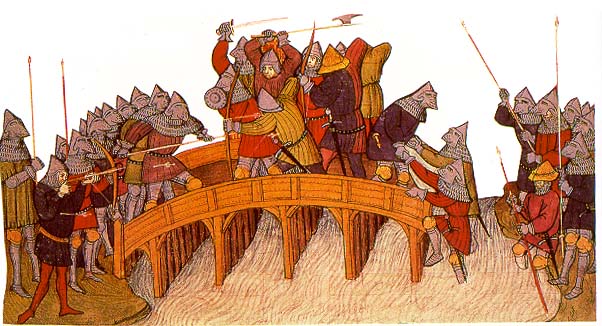
The only example I have been able to find of a man at arms with a buckler
 Attachment: 66.26 KB Attachment: 66.26 KB

Here we see lightly-armed support troops on the bottom, some with bucklers, and well-armed men at arms on the top, none with bucklers.
Regards,
Hugh
www.schlachtschule.org
|
|
    |
 |
Craig Peters

|
 Posted: Thu 31 May, 2007 2:18 pm Post subject: Posted: Thu 31 May, 2007 2:18 pm Post subject: |
 |
|
Hugh,
You need to take a closer look at the ARMA article, since there are several more images there. Also, notice the figure in the lower section of your second image. He's the fourth from the right, with two hands on an axe, and it looks like he's about to be shot with an arrow. You'll notice that he's wearing mail under his tunic. Whether or not he's a man at arms is up for debate, but he certainly isn't a lightly armoured man if he's wearing mail. And I'd be willing to bet that even if the illustrator did not depict it, many or most of the other troops with tunics would have had mail underneath as well.
|
|
  |
 |
|
Hugh Knight
|
 Posted: Thu 31 May, 2007 7:47 pm Post subject: Posted: Thu 31 May, 2007 7:47 pm Post subject: |
 |
|
| Craig Peters wrote: | | You need to take a closer look at the ARMA article, since there are several more images there. Also, notice the figure in the lower section of your second image. He's the fourth from the right, with two hands on an axe, and it looks like he's about to be shot with an arrow. You'll notice that he's wearing mail under his tunic. Whether or not he's a man at arms is up for debate, but he certainly isn't a lightly armoured man if he's wearing mail. And I'd be willing to bet that even if the illustrator did not depict it, many or most of the other troops with tunics would have had mail underneath as well. |
No, Craig, I *don't* need to take a closer look. I looked at the pictures very carefully and found nothing to contradict what I just said.
As for the guy with the mail, you need to reconsider what a "man at arms" is. Craig, his legs are bare. That's not a man at arms, it's a lightly-armored support trooper. And while some of the figures in the lower part of that picture are wearing mail, I'm reasonably sure from the hem of the garment that he's wearing just an aketon, no mail is visible (although there may be some under his tunic). If you look closely you'll see his garment has simple vertical lines; contrast that with the clear mail being depicted on the slumped fellow just to his left.
And even the one figure (second from the left) who is wearing greaves is clearly still a lightly-armored trooper: Note that he's wearing a long-sleeved tunic, unlike the figures above, and no arm armor is apparent.
Please take the time to carefully contrast the folks in the lower half of the picture who are using bucklers with the fully-armored men at arms in the upper half of the picture and it should be clear to you.
Craig, you're implying that anyone in any armor is a man at arms, but that's a straw man argument. A man at arms is a fully armored front-line soldier, often a noble, who is fully armored in cap a pie harness. That isn't true for any of the figures in the bottom half of the picture.
Regards,
Hugh
www.schlachtschule.org
|
|
    |
 |
Greg Coffman

|
 Posted: Thu 31 May, 2007 10:04 pm Post subject: Posted: Thu 31 May, 2007 10:04 pm Post subject: |
 |
|
I think the evidence strongly supports bucklers being used by men-at-arms on the battlefield. Hugh, I'm not sure what ARMA article you looked at but I will try to post some of the many pictures that show heavily armed individuals with bucklers.
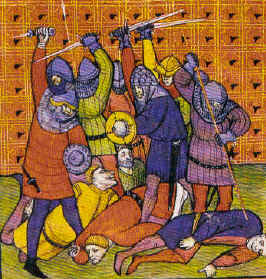
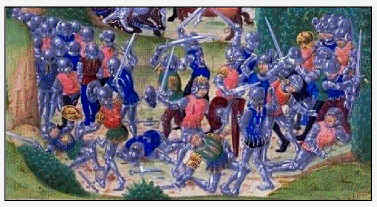
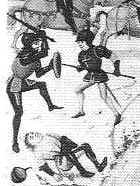
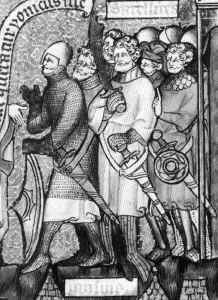
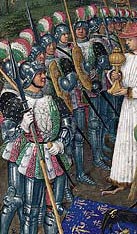
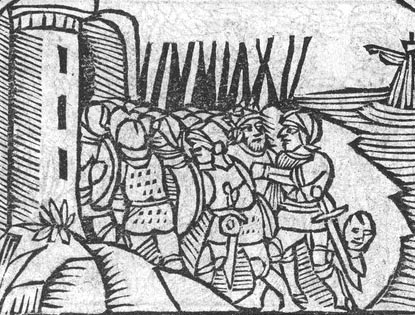

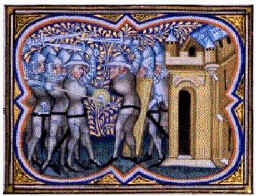
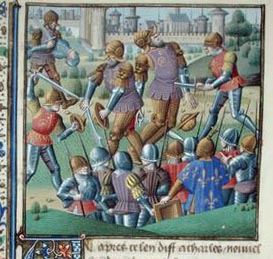
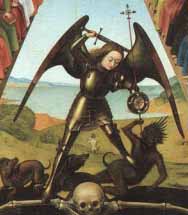
For the word of God is living and active. Sharper than any double-edged sword, it penetrates even to dividing soul and spirit, joints and marrow; it judges the thoughts and attitudes of the heart.
-Hebrews 4:12
|
|
  |
 |
Greg Coffman

|
 Posted: Thu 31 May, 2007 10:05 pm Post subject: Posted: Thu 31 May, 2007 10:05 pm Post subject: |
 |
|
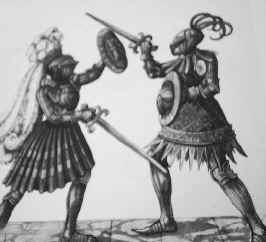
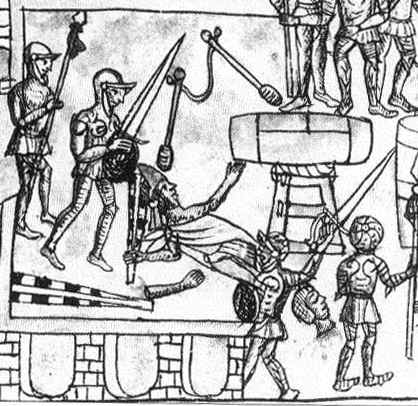
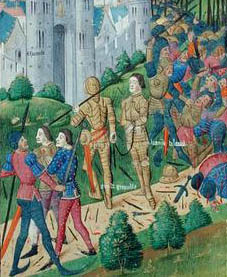
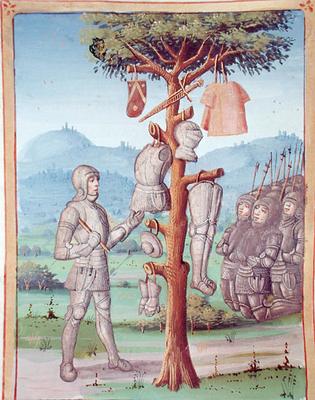
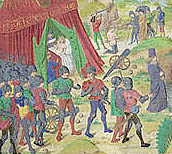
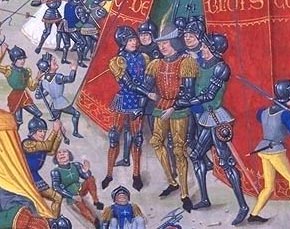
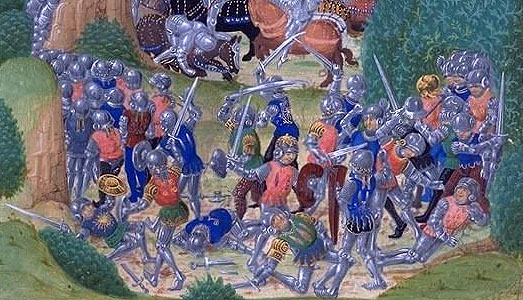
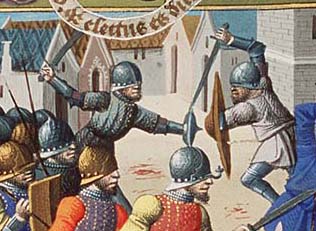
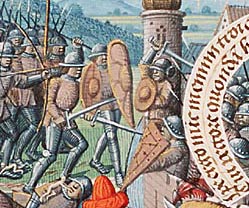
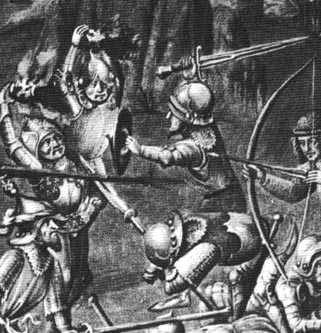
These aren't wierd acceptions. These are the norm.
For the word of God is living and active. Sharper than any double-edged sword, it penetrates even to dividing soul and spirit, joints and marrow; it judges the thoughts and attitudes of the heart.
-Hebrews 4:12
|
|
  |
 |
M. Eversberg II

|
 Posted: Thu 31 May, 2007 10:41 pm Post subject: Posted: Thu 31 May, 2007 10:41 pm Post subject: |
 |
|
Yes, men at arms (which are not always cap a pie in harness) did use bucklers. Strong evidence supports it, and it's even in some fightbooks.
As a side note

I think someone got pranked!
M.
This space for rent or lease.
|
|
      |
 |
Steven H

|
 Posted: Thu 31 May, 2007 11:07 pm Post subject: Posted: Thu 31 May, 2007 11:07 pm Post subject: |
 |
|
I'll agree that the buckler is not the norm for a man-at-arms, but the 'weird exception' connotation goes too far.
John Clements article showed, by my count, at least 15 cap-a-pied armoured soldiers with bucklers. I excluded Saints for the reason Hugh gave, as well as excluding images that I felt were questionable even if I suspected that under the their jupon/surcoat(?) they had full harness.
But in many of those scenes there are plenty of other men-at-arms without bucklers.
And they are not grouped together into formations of all buckler wielding soldiers, so I suspect that we may just have evidence of variation due to personal taste. Even in our modern military where everyone is issued identical kit, some folks still bring along their own gear based on personal preference, availability etc.
Mikael-
Are you asking because of an interpretation/kit you want to put together?
Kunstbruder - Boston area Historical Combat Study
|
|
   |
 |
Steven H

|
 Posted: Thu 31 May, 2007 11:09 pm Post subject: Posted: Thu 31 May, 2007 11:09 pm Post subject: |
 |
|
| M. Eversberg II wrote: | Yes, men at arms (which are not always cap a pie in harness) did use bucklers. Strong evidence supports it, and it's even in some fightbooks.
|
I'm curious. Which fightbook shows sword and buckler in harness?
Thanks.
Kunstbruder - Boston area Historical Combat Study
|
|
   |
 |
Merv Cannon

|
 Posted: Fri 01 Jun, 2007 12:14 am Post subject: Bucklers at War ! Posted: Fri 01 Jun, 2007 12:14 am Post subject: Bucklers at War ! |
 |
|
I have 28 images on file of various combatants using bucklers in war....from archers through fully armoured. I dont suppose that's too many really but there would be many more out there....thats just what Ive found.
But what Id really like to point out that the Buckler is NOT just a little shield ! It is also an offensive weapon ! Thats one reason that its gripped in the fist. The fighting technique is quite different really. To understand weapons and shields its important to use them in accordance with the period manuals !
Thats why my learned friend and group leader believes so strongly in demonstrative archology. He has pointed out very many faults written by 'scholarly' authors who obviously have never bothered to try to use the item about which they profess so much knowlege, much of which was also gained from books written by other authors who have also never used the item, etc.
But certinally Bucklers were also a prefered " little shield " for the traveller to take on the proverbial pilgramage too.
Cheers
Merv ....... KOLR
http://www.lionrampant.com.au/
"Then let slip the dogs of war ! "......Woof !
|
|
   |
 |
Elling Polden

|
 Posted: Fri 01 Jun, 2007 12:40 am Post subject: Posted: Fri 01 Jun, 2007 12:40 am Post subject: |
 |
|
Sword and buckler is a very decent backup option. While not a primary combo, it is certainly a good choice for a polearm wielding heavy infantryman to carry a sword and buckler.
A sword and shield or polearm wielder might have the edge on him on a level field, but when swords come out, ranks have probably broken anyway.
In any case it is superior to a plain arming sword.
"this [fight] looks curious, almost like a game. See, they are looking around them before they fall, to find a dry spot to fall on, or they are falling on their shields. Can you see blood on their cloths and weapons? No. This must be trickery."
-Reidar Sendeman, from King Sverre's Saga, 1201
|
|
    |
 |
|
Mikael Ranelius
|
 Posted: Fri 01 Jun, 2007 3:10 am Post subject: Posted: Fri 01 Jun, 2007 3:10 am Post subject: |
 |
|
Thanks, interesting article and interesting points made
Steven H:
I was thinking of a late 14th century equipment for a lower man-at-arms, i.e. a well-to-do gentleman that fought armoured together with the knights but who couldn't afford the latest italian high-quality armour. I guess more like this guy rather than this guy
|
|
  |
 |
|
Hugh Knight
|
 Posted: Fri 01 Jun, 2007 6:45 am Post subject: Posted: Fri 01 Jun, 2007 6:45 am Post subject: |
 |
|
| Greg Coffman wrote: | | I think the evidence strongly supports bucklers being used by men-at-arms on the battlefield. Hugh, I'm not sure what ARMA article you looked at but I will try to post some of the many pictures that show heavily armed individuals with bucklers. |
Gary, look again at those pictures: Almost all of them show the men armed with bucklers to be in a reduced harness; the first one, for example, has no leg armor; many of the others had no gauntlets or a light helmet. Those aren't fully-armored men at arms, they're lightly-armed support troops! Some of them have a lot of armor, it's true, but almost never a full harness. and some of them aren't bucklers; they're just small shields (meaning they have enarmes). Round shields are not bucklers, either. The specific question was about men at arms, the OP specifically exluded support troops, using bucklers.
One of them shows someone in mostly full plate, but he's carrying a bill. He's an English Billman, not a man at arms. Now we know some of them wore pretty comprehensive armor (although the majority did not), so think about the artist: He's painting a picture, and someone says the billman leading a captive wears a lot of armor... and voila, you have that painting. Remember that some English billmen hired themselves out as elite guards to continental lords, and were often heavily armored, but they were still billmen and archers, not men at arms. Other paintings show round shields, but not bucklers. Take away all of that and you're left with very few pictures that are even questionable, and that makes sense when you consider how limited a buckler would be for a fully-armored man at arms.
I forget who wrote that a buckler is an offensive weapon, not just for blocking, and while that's true for Blossfechten, it would be pretty limited in combat with fully-armored men; a gauntlet, especially one with gadlings, would do as well against lightly-armored troops if you happen to come up against any.
Regards,
Hugh
www.schlachtschule.org
|
|
    |
 |
Gary A. Chelette

|
 Posted: Fri 01 Jun, 2007 10:52 am Post subject: Posted: Fri 01 Jun, 2007 10:52 am Post subject: |
 |
|
I have many years in SCA combat using both full shield and bucklers. One thing I know is that with a buckler, you'd better be light on your feet! Heavy plate or even chain can slow you down and cause you to exit the party real quick. I used flankers in lite armour and bucklers to run in and harrass spearmen and archers. They had to be quick and mobile. They also worked very well as backup on a shield wall when the troops came crashing through.
Men at arms are like many knights, how much could they afford?
I have read of poor knights going into battle with only a gambson, shield and club. Are men at arms any different?
Also take in account that those paintings are done by artist, not warriors. Not everything in those paintings is accurate, just like the Blonde hair, blue eyed Jesus.
The use of the buckler by anyone depended on the wealth and skill of the person as well as what kind of fighting there was to be.
|
|
   |
 |
Craig Peters

|
 Posted: Fri 01 Jun, 2007 2:34 pm Post subject: Posted: Fri 01 Jun, 2007 2:34 pm Post subject: |
 |
|
| Hugh Knight wrote: | | Greg Coffman wrote: | | I think the evidence strongly supports bucklers being used by men-at-arms on the battlefield. Hugh, I'm not sure what ARMA article you looked at but I will try to post some of the many pictures that show heavily armed individuals with bucklers. |
Gary, look again at those pictures: Almost all of them show the men armed with bucklers to be in a reduced harness; the first one, for example, has no leg armor; many of the others had no gauntlets or a light helmet. Those aren't fully-armored men at arms, they're lightly-armed support troops! Some of them have a lot of armor, it's true, but almost never a full harness. and some of them aren't bucklers; they're just small shields (meaning they have enarmes). Round shields are not bucklers, either. The specific question was about men at arms, the OP specifically exluded support troops, using bucklers.
One of them shows someone in mostly full plate, but he's carrying a bill. He's an English Billman, not a man at arms. Now we know some of them wore pretty comprehensive armor (although the majority did not), so think about the artist: He's painting a picture, and someone says the billman leading a captive wears a lot of armor... and voila, you have that painting. Remember that some English billmen hired themselves out as elite guards to continental lords, and were often heavily armored, but they were still billmen and archers, not men at arms. Other paintings show round shields, but not bucklers. Take away all of that and you're left with very few pictures that are even questionable, and that makes sense when you consider how limited a buckler would be for a fully-armored man at arms.
I forget who wrote that a buckler is an offensive weapon, not just for blocking, and while that's true for Blossfechten, it would be pretty limited in combat with fully-armored men; a gauntlet, especially one with gadlings, would do as well against lightly-armored troops if you happen to come up against any. |
Hugh,
What evidence do you have that indicates that men-at-arms would typically or always be in a full harness? Men-at-arms, after all, were often fighting men who did not want to deal with the extra associated expenses of becoming a knight, and undoubtedly some of them would not have had enough money for a full harness. I think your definition of "man-at-arms" is too restrictive.
|
|
  |
 |
|
Hugh Knight
|
 Posted: Fri 01 Jun, 2007 3:04 pm Post subject: Posted: Fri 01 Jun, 2007 3:04 pm Post subject: |
 |
|
| Craig Peters wrote: | | What evidence do you have that indicates that men-at-arms would typically or always be in a full harness? Men-at-arms, after all, were often fighting men who did not want to deal with the extra associated expenses of becoming a knight, and undoubtedly some of them would not have had enough money for a full harness. I think your definition of "man-at-arms" is too restrictive. |
Craig,
That's the definition of a man at arms.
Regards,
Hugh
www.schlachtschule.org
|
|
    |
 |
M. Eversberg II

|
 Posted: Fri 01 Jun, 2007 7:01 pm Post subject: Posted: Fri 01 Jun, 2007 7:01 pm Post subject: |
 |
|
All knights where men at arms, but not all men at arms where knights. I'm sure many men at arms carried less equipment than others either through A) lack of personal funds or B) loss in battle.
M.
This space for rent or lease.
|
|
      |
 |
|
Hugh Knight
|
 Posted: Fri 01 Jun, 2007 7:46 pm Post subject: Posted: Fri 01 Jun, 2007 7:46 pm Post subject: |
 |
|
| M. Eversberg II wrote: | | All knights where men at arms, but not all men at arms where knights. I'm sure many men at arms carried less equipment than others either through A) lack of personal funds or B) loss in battle. |
The definition of a man at arms is somone who can take the field in a full harness and weapons. No, not all men at arms are knights, but they are all men who can fully equip themselves. That's how the term is used in virtually every academic source I've ever seen. You're talking about common soldiers, and such men were usually peasant levies (e.g., the French back-up troops during the HYW who really never saw much fighting in major battles and who *certainly* wouldn't have full harnesses) or were specialized suppoert troops such as bow-or billmen. Some of the latter, especially the billmen, had nearly complete harnesses, but fulfilled a different role from that of the men at arms.
Regards,
Hugh
www.schlachtschule.org
|
|
    |
 |
|
|
You cannot post new topics in this forum
You cannot reply to topics in this forum
You cannot edit your posts in this forum
You cannot delete your posts in this forum
You cannot vote in polls in this forum
You cannot attach files in this forum
You can download files in this forum
|
All contents © Copyright 2003-2024 myArmoury.com — All rights reserved
Discussion forums powered by phpBB © The phpBB Group
Switch to the Basic Low-bandwidth Version of the forum
|

